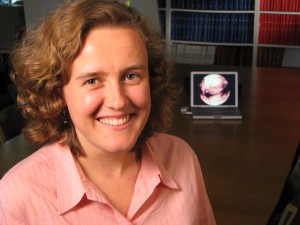 Naomi McClure-Griffiths
Naomi McClure-Griffiths
Where do we live? And what’s the neighbourhood like? Astronomer Naomi McClure-Griffiths has set about answering these questions with the help of “The Dish”, the 64-metre Parkes radio telescope.
Her research has dramatically reshaped our knowledge of the structure and evolution of our galactic home – the Milky Way.
It turns out that we don’t really know what our galaxy looks like. The familiar images of our galaxy are really little more than guesses.
“Studying the shape of the galaxy from Earth is like an ant studying Sydney from a suburban garden in Penrith,” says Naomi.
But that’s exactly the challenge this 31-year-old radio astronomer has taken on. Her studies of the Milky Way over the past ten years have already led to the discovery of a new spiral arm, and changed many long-held ideas about the evolution of our galaxy.
Just five years after completing her PhD, Naomi, a Senior Post-Doctoral Fellow at the CSIRO Australia Telescope National Facility, is now recognised internationally as an expert on the Milky Way.
For her insight into the structure of our galaxy, and her research leadership, Naomi McClure-Griffiths has been awarded the 2006 Malcolm McIntosh Prize for Physical Scientist of the Year.
Born in Atlanta, Georgia, Naomi says she fell into astronomy, having entered college hoping to do physics or French. “I had a very good professor who happened to be a radio astronomer. You can study really small or really big things in physics. The public finds the really big more interesting so I thought there was a better future in that.”
Naomi first came to Australia and the Parkes radio telescope as an undergraduate student. Within hours of her arrival, she was standing on “The Dish”, before starting her first night of observing.
“I fell in love with the telescope, Australia, and its unique view of the Milky Way. The galactic centre is directly overhead when you’re in the southern hemisphere. That’s what makes astronomy in Australia special,” says Naomi.
Naomi relocated permanently to Australia in 2001 as a CSIRO Bolton Post Doctoral Fellow at the Australia Telescope National Facility. Her research has focussed on the structure and dynamics of hydrogen gas in the Milky Way. Hydrogen is the most pervasive atom in the universe and it acts as a tracer, outlining the shape of the Milky Way and telling the story of the evolution of its interstellar medium – the gases and dust between stars.
While doing her PhD, Naomi led the Southern Galactic Plane Survey, which mapped the hydrogen gas in over half of the stellar disk of the Milky Way for the International Galactic Plane Survey.
Naomi used the survey results to study our galaxy’s “weather” – the movement of interstellar gas over hundreds of thousands of years. In particular she studied huge bubbles blown in the disk of our galaxy by the explosion of massive stars. She has found most of the large bubbles, or shells, known from the Southern Milky Way, and has shown how these holes act to sweep away interstellar gas and shred the spiral arms in the galaxy. Where these holes have broken through the plane of the galaxy, huge chimneys of relatively empty space have been created. Naomi has personally discovered two chimneys, one of which is the only one known to extend through the top and bottom of the galactic plane.
In 2004 she expanded her research to include looking at the structure of the galaxy as a whole. As a result, she discovered a new spiral arm. Now, astronomers are redrawing the map of the galaxy.
Naomi is now the Principal Investigator on the Galactic All Sky Survey, leading a team to create the most sensitive and high resolution all-sky atlas of hydrogen. Despite offers of prestigious fellowships to return to the US, Naomi plans to stay in Australia, and hopes one day to use the proposed Square Kilometre Array telescope to compare our galaxy with other galaxies.
“McClure-Griffiths is one of the strongest leaders in astronomy of her generation in the world.”
John Dickey, Professor and Head of Discipline in Physics, University of Tasmania
Autobiographical Details
2004- Promoted to Senior Post-Doctoral Fellow
2001-04 Bolton Post-Doctoral Fellow, Australian Telescope National Facility, CSIRO
1997-2001 Ph.D. (Astrophysics), University of Minnesota, USA
1993-97 BA with Honours (Physics), Oberlin College, Ohio, USA
1975 Born Atlanta, Georgia, USA
Career Highlights
2004 Hubble Fellowship, Space Telescope Science Institute (declined)
2004 Jansky Fellowship, US National Radio Astronomy Observatory (declined)
2003 Best Dissertation Award, Physical Sciences and Engineering, University of Minnesota
2001 Aneesur Rahman Prize in Physics, University of Minnesota
2001 Jansky Fellowship, US National Radio Astronomy Observatory (declined)
1999 NASA Graduate Student Researchers Program Fellowship
1996 National Association for Women in Construction Scholarship
1996 Robert Weinstock Award in Physics, Oberlin College
Research Highlights
Leadership role in two major surveys of the Milky Way
- Principal Investigator, Southern Galactic Plane Survey (2000-04)
- Principal Investigator, Galactic All Sky Survey (2004-).
- Discovery of an outer spiral arm in the Milky Way (2004). The arm is more than 77000 light years long and a few thousand light years thick.
- Catalogued 19 new shells in our galaxy (published 2002) and two chimneys (2000 and 2006), where hot gas is forced upwards towards the halo.
- 37 scientific papers published in international refereed journals, a further 37 non-refereed publications and 473 citations of her work.
- Regularly invited to lecture internationally including in the US, Canada, Europe and Japan.


